Knowledge Management Implementation in Apple Inc.
VerifiedAdded on 2023/04/23
|12
|3601
|53
AI Summary
This report discusses the implementation of knowledge management in Apple Inc. and the challenges faced during the process. It also highlights the effectiveness of the KM implementation and the success metrics used in the process. The report provides insights into the organisational overview, the nature of the KM initiative, and the process of KM implementation in Apple Inc.
Contribute Materials
Your contribution can guide someone’s learning journey. Share your
documents today.
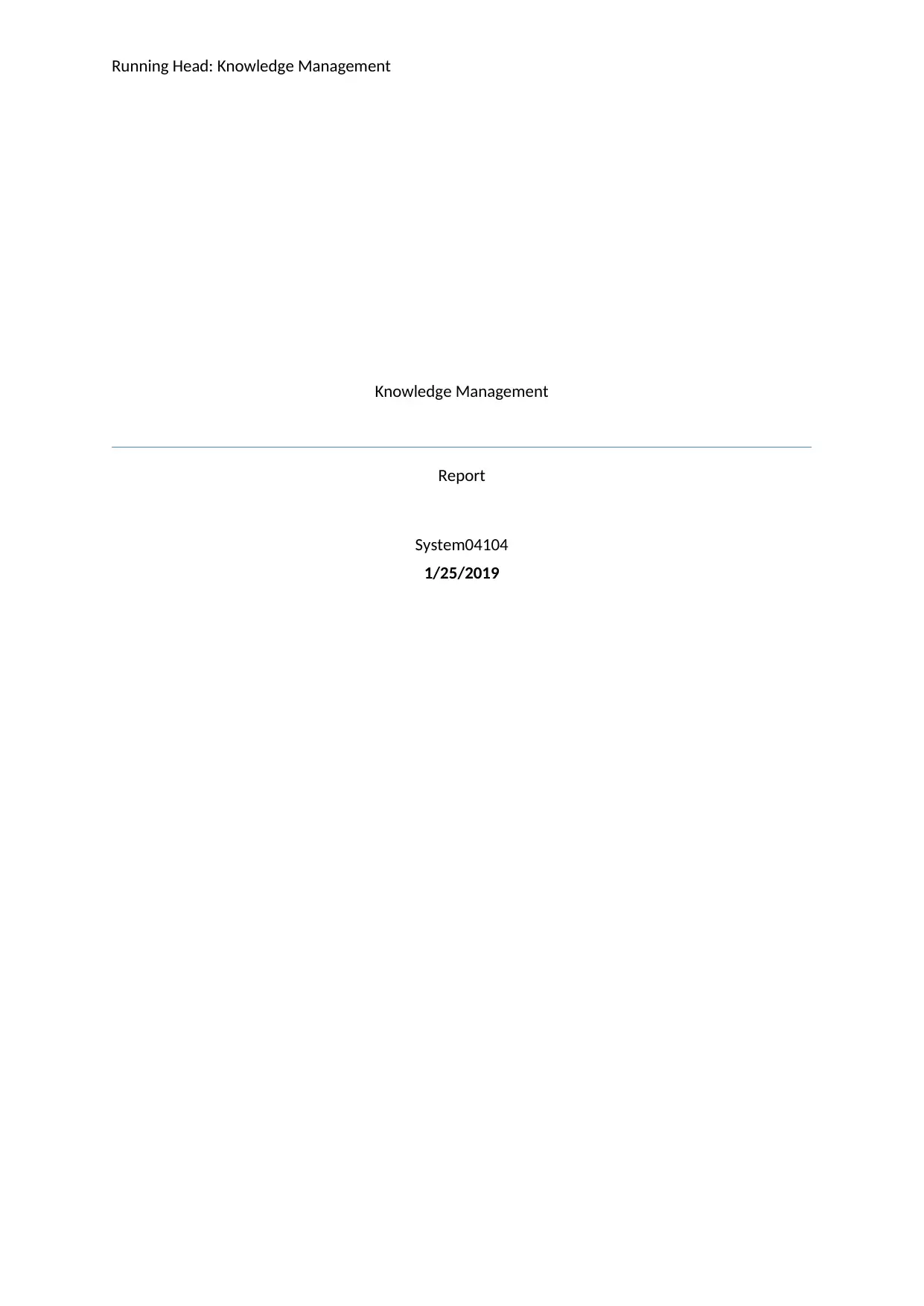
Running Head: Knowledge Management
Knowledge Management
Report
System04104
1/25/2019
Knowledge Management
Report
System04104
1/25/2019
Secure Best Marks with AI Grader
Need help grading? Try our AI Grader for instant feedback on your assignments.
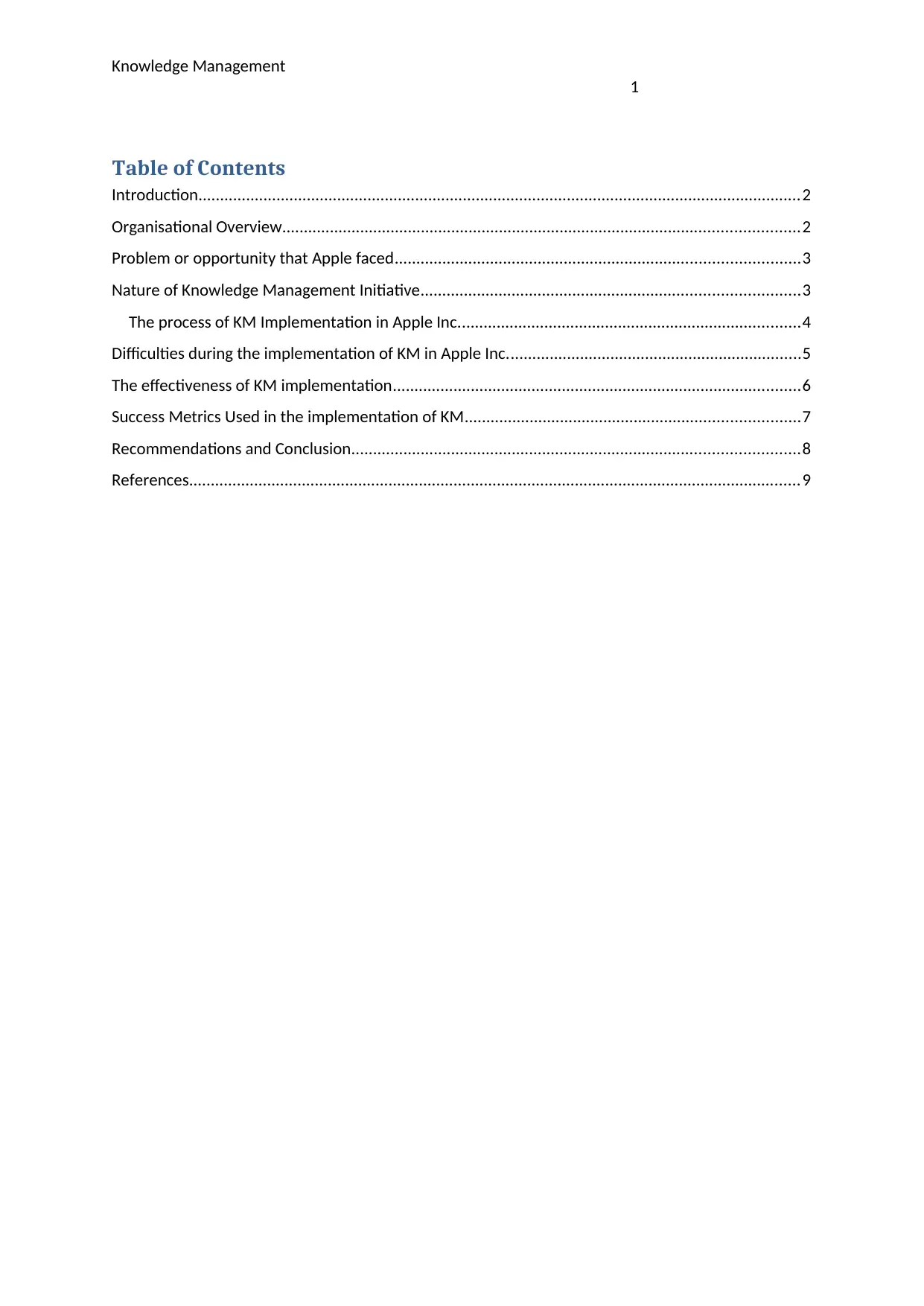
Knowledge Management
1
Table of Contents
Introduction...........................................................................................................................................2
Organisational Overview.......................................................................................................................2
Problem or opportunity that Apple faced.............................................................................................3
Nature of Knowledge Management Initiative.......................................................................................3
The process of KM Implementation in Apple Inc...............................................................................4
Difficulties during the implementation of KM in Apple Inc....................................................................5
The effectiveness of KM implementation..............................................................................................6
Success Metrics Used in the implementation of KM.............................................................................7
Recommendations and Conclusion.......................................................................................................8
References.............................................................................................................................................9
1
Table of Contents
Introduction...........................................................................................................................................2
Organisational Overview.......................................................................................................................2
Problem or opportunity that Apple faced.............................................................................................3
Nature of Knowledge Management Initiative.......................................................................................3
The process of KM Implementation in Apple Inc...............................................................................4
Difficulties during the implementation of KM in Apple Inc....................................................................5
The effectiveness of KM implementation..............................................................................................6
Success Metrics Used in the implementation of KM.............................................................................7
Recommendations and Conclusion.......................................................................................................8
References.............................................................................................................................................9
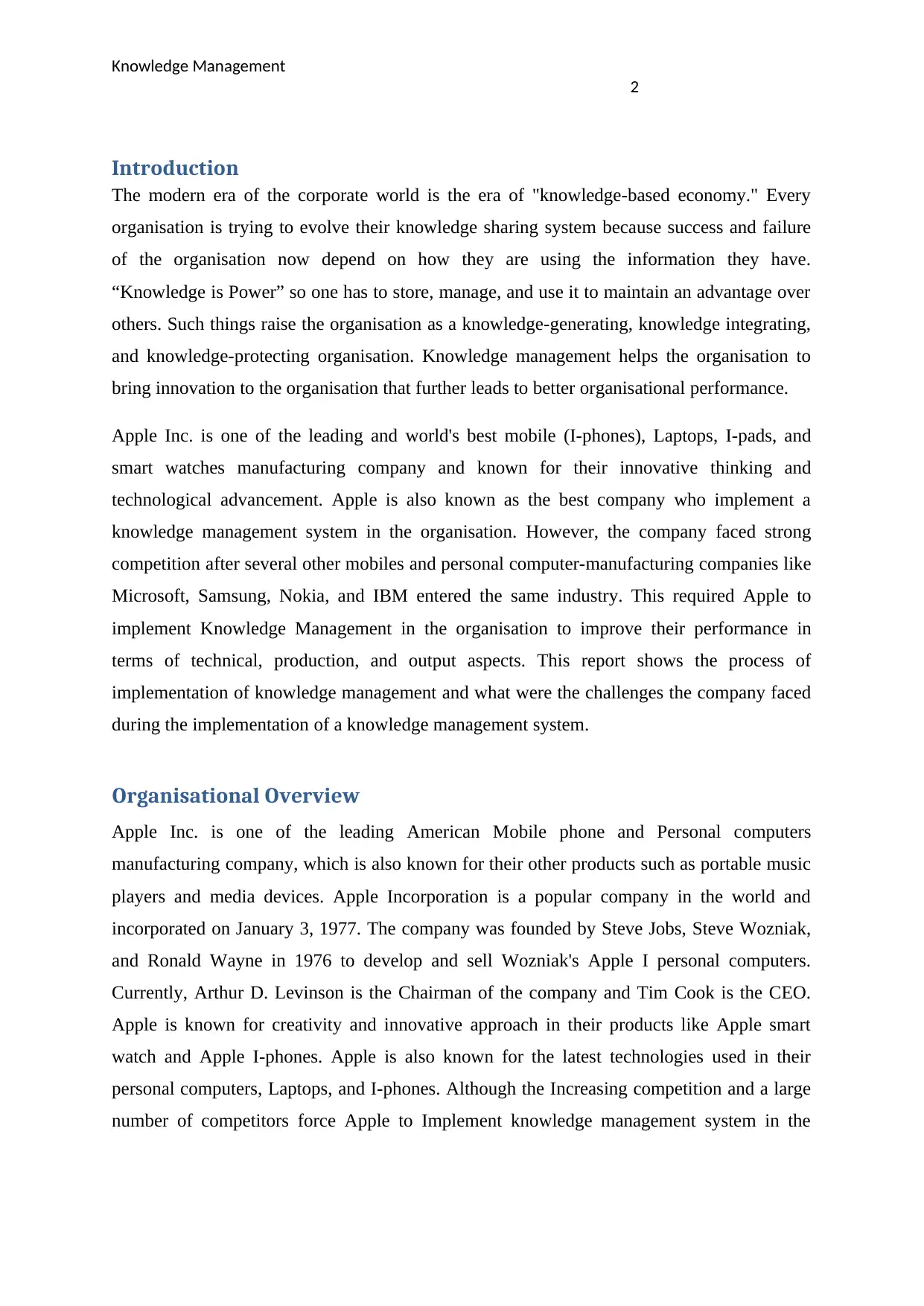
Knowledge Management
2
Introduction
The modern era of the corporate world is the era of "knowledge-based economy." Every
organisation is trying to evolve their knowledge sharing system because success and failure
of the organisation now depend on how they are using the information they have.
“Knowledge is Power” so one has to store, manage, and use it to maintain an advantage over
others. Such things raise the organisation as a knowledge-generating, knowledge integrating,
and knowledge-protecting organisation. Knowledge management helps the organisation to
bring innovation to the organisation that further leads to better organisational performance.
Apple Inc. is one of the leading and world's best mobile (I-phones), Laptops, I-pads, and
smart watches manufacturing company and known for their innovative thinking and
technological advancement. Apple is also known as the best company who implement a
knowledge management system in the organisation. However, the company faced strong
competition after several other mobiles and personal computer-manufacturing companies like
Microsoft, Samsung, Nokia, and IBM entered the same industry. This required Apple to
implement Knowledge Management in the organisation to improve their performance in
terms of technical, production, and output aspects. This report shows the process of
implementation of knowledge management and what were the challenges the company faced
during the implementation of a knowledge management system.
Organisational Overview
Apple Inc. is one of the leading American Mobile phone and Personal computers
manufacturing company, which is also known for their other products such as portable music
players and media devices. Apple Incorporation is a popular company in the world and
incorporated on January 3, 1977. The company was founded by Steve Jobs, Steve Wozniak,
and Ronald Wayne in 1976 to develop and sell Wozniak's Apple I personal computers.
Currently, Arthur D. Levinson is the Chairman of the company and Tim Cook is the CEO.
Apple is known for creativity and innovative approach in their products like Apple smart
watch and Apple I-phones. Apple is also known for the latest technologies used in their
personal computers, Laptops, and I-phones. Although the Increasing competition and a large
number of competitors force Apple to Implement knowledge management system in the
2
Introduction
The modern era of the corporate world is the era of "knowledge-based economy." Every
organisation is trying to evolve their knowledge sharing system because success and failure
of the organisation now depend on how they are using the information they have.
“Knowledge is Power” so one has to store, manage, and use it to maintain an advantage over
others. Such things raise the organisation as a knowledge-generating, knowledge integrating,
and knowledge-protecting organisation. Knowledge management helps the organisation to
bring innovation to the organisation that further leads to better organisational performance.
Apple Inc. is one of the leading and world's best mobile (I-phones), Laptops, I-pads, and
smart watches manufacturing company and known for their innovative thinking and
technological advancement. Apple is also known as the best company who implement a
knowledge management system in the organisation. However, the company faced strong
competition after several other mobiles and personal computer-manufacturing companies like
Microsoft, Samsung, Nokia, and IBM entered the same industry. This required Apple to
implement Knowledge Management in the organisation to improve their performance in
terms of technical, production, and output aspects. This report shows the process of
implementation of knowledge management and what were the challenges the company faced
during the implementation of a knowledge management system.
Organisational Overview
Apple Inc. is one of the leading American Mobile phone and Personal computers
manufacturing company, which is also known for their other products such as portable music
players and media devices. Apple Incorporation is a popular company in the world and
incorporated on January 3, 1977. The company was founded by Steve Jobs, Steve Wozniak,
and Ronald Wayne in 1976 to develop and sell Wozniak's Apple I personal computers.
Currently, Arthur D. Levinson is the Chairman of the company and Tim Cook is the CEO.
Apple is known for creativity and innovative approach in their products like Apple smart
watch and Apple I-phones. Apple is also known for the latest technologies used in their
personal computers, Laptops, and I-phones. Although the Increasing competition and a large
number of competitors force Apple to Implement knowledge management system in the
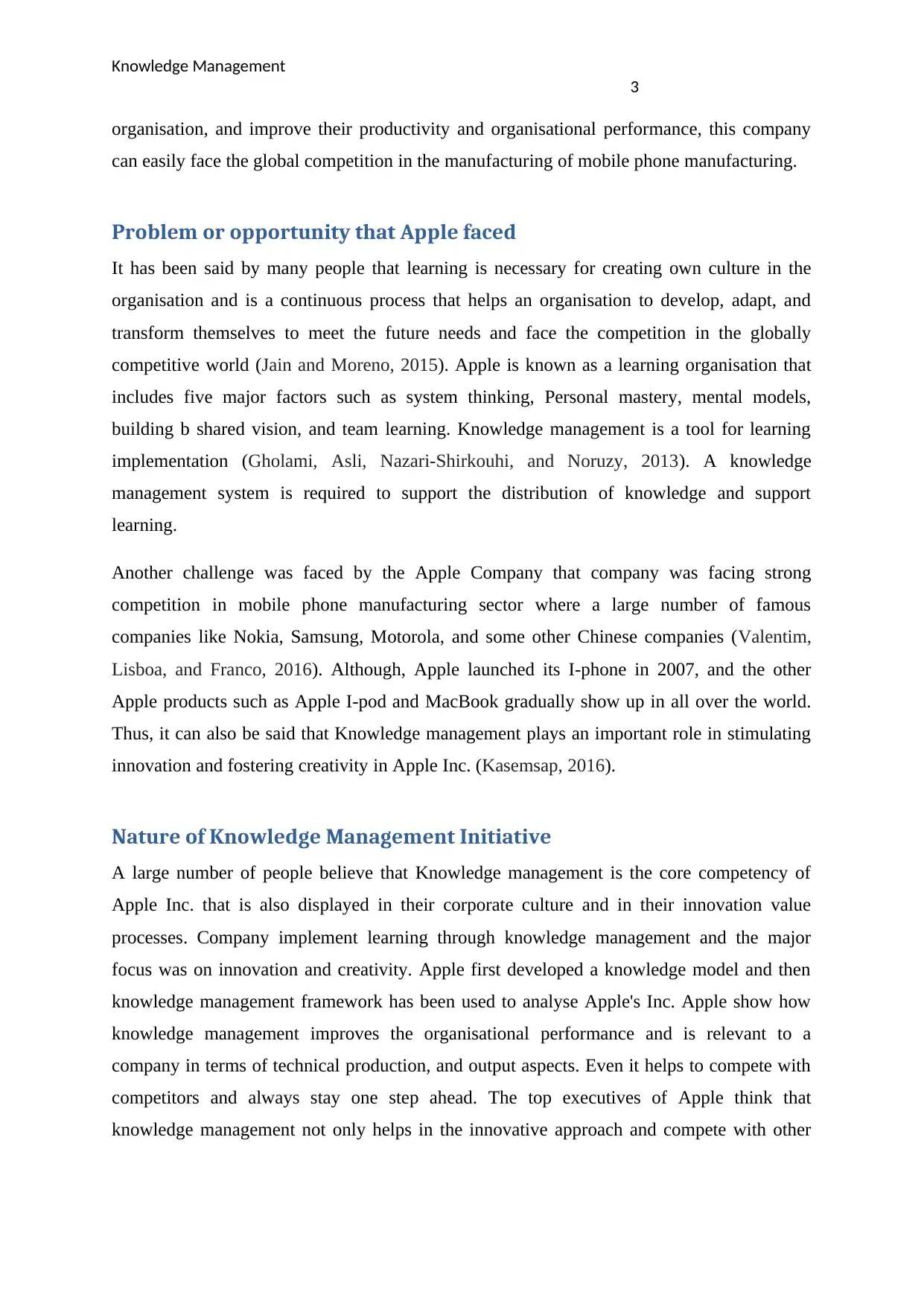
Knowledge Management
3
organisation, and improve their productivity and organisational performance, this company
can easily face the global competition in the manufacturing of mobile phone manufacturing.
Problem or opportunity that Apple faced
It has been said by many people that learning is necessary for creating own culture in the
organisation and is a continuous process that helps an organisation to develop, adapt, and
transform themselves to meet the future needs and face the competition in the globally
competitive world (Jain and Moreno, 2015). Apple is known as a learning organisation that
includes five major factors such as system thinking, Personal mastery, mental models,
building b shared vision, and team learning. Knowledge management is a tool for learning
implementation (Gholami, Asli, Nazari-Shirkouhi, and Noruzy, 2013). A knowledge
management system is required to support the distribution of knowledge and support
learning.
Another challenge was faced by the Apple Company that company was facing strong
competition in mobile phone manufacturing sector where a large number of famous
companies like Nokia, Samsung, Motorola, and some other Chinese companies (Valentim,
Lisboa, and Franco, 2016). Although, Apple launched its I-phone in 2007, and the other
Apple products such as Apple I-pod and MacBook gradually show up in all over the world.
Thus, it can also be said that Knowledge management plays an important role in stimulating
innovation and fostering creativity in Apple Inc. (Kasemsap, 2016).
Nature of Knowledge Management Initiative
A large number of people believe that Knowledge management is the core competency of
Apple Inc. that is also displayed in their corporate culture and in their innovation value
processes. Company implement learning through knowledge management and the major
focus was on innovation and creativity. Apple first developed a knowledge model and then
knowledge management framework has been used to analyse Apple's Inc. Apple show how
knowledge management improves the organisational performance and is relevant to a
company in terms of technical production, and output aspects. Even it helps to compete with
competitors and always stay one step ahead. The top executives of Apple think that
knowledge management not only helps in the innovative approach and compete with other
3
organisation, and improve their productivity and organisational performance, this company
can easily face the global competition in the manufacturing of mobile phone manufacturing.
Problem or opportunity that Apple faced
It has been said by many people that learning is necessary for creating own culture in the
organisation and is a continuous process that helps an organisation to develop, adapt, and
transform themselves to meet the future needs and face the competition in the globally
competitive world (Jain and Moreno, 2015). Apple is known as a learning organisation that
includes five major factors such as system thinking, Personal mastery, mental models,
building b shared vision, and team learning. Knowledge management is a tool for learning
implementation (Gholami, Asli, Nazari-Shirkouhi, and Noruzy, 2013). A knowledge
management system is required to support the distribution of knowledge and support
learning.
Another challenge was faced by the Apple Company that company was facing strong
competition in mobile phone manufacturing sector where a large number of famous
companies like Nokia, Samsung, Motorola, and some other Chinese companies (Valentim,
Lisboa, and Franco, 2016). Although, Apple launched its I-phone in 2007, and the other
Apple products such as Apple I-pod and MacBook gradually show up in all over the world.
Thus, it can also be said that Knowledge management plays an important role in stimulating
innovation and fostering creativity in Apple Inc. (Kasemsap, 2016).
Nature of Knowledge Management Initiative
A large number of people believe that Knowledge management is the core competency of
Apple Inc. that is also displayed in their corporate culture and in their innovation value
processes. Company implement learning through knowledge management and the major
focus was on innovation and creativity. Apple first developed a knowledge model and then
knowledge management framework has been used to analyse Apple's Inc. Apple show how
knowledge management improves the organisational performance and is relevant to a
company in terms of technical production, and output aspects. Even it helps to compete with
competitors and always stay one step ahead. The top executives of Apple think that
knowledge management not only helps in the innovative approach and compete with other
Secure Best Marks with AI Grader
Need help grading? Try our AI Grader for instant feedback on your assignments.

Knowledge Management
4
players in the market rather it also helps in the line of production. Apple Inc. used Senge’s
five disciplines to exam its organisational learning success:
1. System Thinking: The system thinking helps to understand the whole problem or
system such as people, procedure of work, rules, work environment, and structure. It
also helps in determining the advancement of the organisation.
2. Personal Mastery: Personal mastery focuses on personal goals and self-development
of employees and people working in the Apple Inc. The Former CEO Late Steve Jobs
addressed that manager should set reasonable goals for both staffs and for self as well
and inducing training programs on the regular basis to improve the learning.
3. Mental Mode: The mental mode focuses on principle foundations and willingness to
learn and adapt the new concept faster than competitors. To follow the mental model,
Apple has changed its production system and instead of producing only computers
and i-phones, they produce smartwatches, computer electronics, and other sphere
parts of their devices.
4. Building Shared Vision: The main focus of the company is to make aware the
customers about the Apple products and consulting them to know about their
requirements, and co-creating new products and new features in existing products.
Many professionals of large companies resigned from their position in order to be
employed by Apple, because they saw that Apple was offering something different.
5. Team Learning: This discipline focuses on developing the performance and
improves the team productivity to create the results is what the member of teams truly
desire. A good leader leads the team from the front and converts the impossible task
into a possible one.
The process of KM Implementation in Apple Inc.
To collect knowledge from different sources, Apple Inc. had formulated solid policies,
methods, and logic. The company collected information from various sources such as
Stakeholders, customers, staff, for its KM tool. The implementation process of knowledge
management went through several steps. These are as follow:
1. Infrastructure Evaluation: The very first step before implementing knowledge
management is to evaluate the infrastructure of the organisation.
2. KM system design and development: The second phase is creating a design for the
KM system and ensuring there should be an effective leveraging of infrastructure that
4
players in the market rather it also helps in the line of production. Apple Inc. used Senge’s
five disciplines to exam its organisational learning success:
1. System Thinking: The system thinking helps to understand the whole problem or
system such as people, procedure of work, rules, work environment, and structure. It
also helps in determining the advancement of the organisation.
2. Personal Mastery: Personal mastery focuses on personal goals and self-development
of employees and people working in the Apple Inc. The Former CEO Late Steve Jobs
addressed that manager should set reasonable goals for both staffs and for self as well
and inducing training programs on the regular basis to improve the learning.
3. Mental Mode: The mental mode focuses on principle foundations and willingness to
learn and adapt the new concept faster than competitors. To follow the mental model,
Apple has changed its production system and instead of producing only computers
and i-phones, they produce smartwatches, computer electronics, and other sphere
parts of their devices.
4. Building Shared Vision: The main focus of the company is to make aware the
customers about the Apple products and consulting them to know about their
requirements, and co-creating new products and new features in existing products.
Many professionals of large companies resigned from their position in order to be
employed by Apple, because they saw that Apple was offering something different.
5. Team Learning: This discipline focuses on developing the performance and
improves the team productivity to create the results is what the member of teams truly
desire. A good leader leads the team from the front and converts the impossible task
into a possible one.
The process of KM Implementation in Apple Inc.
To collect knowledge from different sources, Apple Inc. had formulated solid policies,
methods, and logic. The company collected information from various sources such as
Stakeholders, customers, staff, for its KM tool. The implementation process of knowledge
management went through several steps. These are as follow:
1. Infrastructure Evaluation: The very first step before implementing knowledge
management is to evaluate the infrastructure of the organisation.
2. KM system design and development: The second phase is creating a design for the
KM system and ensuring there should be an effective leveraging of infrastructure that

Knowledge Management
5
is needed for the implantation of the KM system. Apple focuses on the objective of
the system, cost of the system, future plans, and strength and weakness of the system.
In this phase company generally focuses on knowledge audit and analysis, design the
KM team that further creating KM blueprint, and develop system. Through this,
Apple was focusing on great technological products and constantly focusing on
innovation (Donate and de Pablo, 2015).
3. Deployment: In Apple, there is a large number of people are working including
engineers, managers, technological experts, etc. and company provide them with a
very good working environment. Through this, Apple mostly focuses on Result driven
incremental methodology and thus company had to focus on their culture that how the
KM system fit in the organisation without affecting the employee and its
shareholder’s interest.
4. Evaluation: Evaluation of KM system is the last phase in KM implementation.
Looking at Apple’s performance it can be said that desire to work in Apple Inc. is a
dream of many people, and even competitors are looking for quickly copy the Apple
product features. Apple usage KM as a tool to measure the relevancy of their
innovation in the products and culture of the company also supported Apple's KM
system implementation in the organisation.
Difficulties during the implementation of KM in Apple Inc.
Apple has encountered numerous challenges and problems during the process of
implementing KMS. The major challenge that Apple has faced is about managing the
knowledge source because it exists in the company in various forms and is widely
distributed. Thus, there was a need for a common interface that would help, allow, and
access all the different types of knowledge. Another problem was that the company
sometimes fail to manage and capture learning experiences. The System did not capture
tacit information that inherent within an individual (Yeh, Yeh, and Chen, 2012).
Secondly, there is often an informal and inadequate communication within the
organisation and outside of the organisation across the various, such as on functional and
geographic basis, which limit the process of updating knowledge (Meihami and Meihami,
2014).
5
is needed for the implantation of the KM system. Apple focuses on the objective of
the system, cost of the system, future plans, and strength and weakness of the system.
In this phase company generally focuses on knowledge audit and analysis, design the
KM team that further creating KM blueprint, and develop system. Through this,
Apple was focusing on great technological products and constantly focusing on
innovation (Donate and de Pablo, 2015).
3. Deployment: In Apple, there is a large number of people are working including
engineers, managers, technological experts, etc. and company provide them with a
very good working environment. Through this, Apple mostly focuses on Result driven
incremental methodology and thus company had to focus on their culture that how the
KM system fit in the organisation without affecting the employee and its
shareholder’s interest.
4. Evaluation: Evaluation of KM system is the last phase in KM implementation.
Looking at Apple’s performance it can be said that desire to work in Apple Inc. is a
dream of many people, and even competitors are looking for quickly copy the Apple
product features. Apple usage KM as a tool to measure the relevancy of their
innovation in the products and culture of the company also supported Apple's KM
system implementation in the organisation.
Difficulties during the implementation of KM in Apple Inc.
Apple has encountered numerous challenges and problems during the process of
implementing KMS. The major challenge that Apple has faced is about managing the
knowledge source because it exists in the company in various forms and is widely
distributed. Thus, there was a need for a common interface that would help, allow, and
access all the different types of knowledge. Another problem was that the company
sometimes fail to manage and capture learning experiences. The System did not capture
tacit information that inherent within an individual (Yeh, Yeh, and Chen, 2012).
Secondly, there is often an informal and inadequate communication within the
organisation and outside of the organisation across the various, such as on functional and
geographic basis, which limit the process of updating knowledge (Meihami and Meihami,
2014).
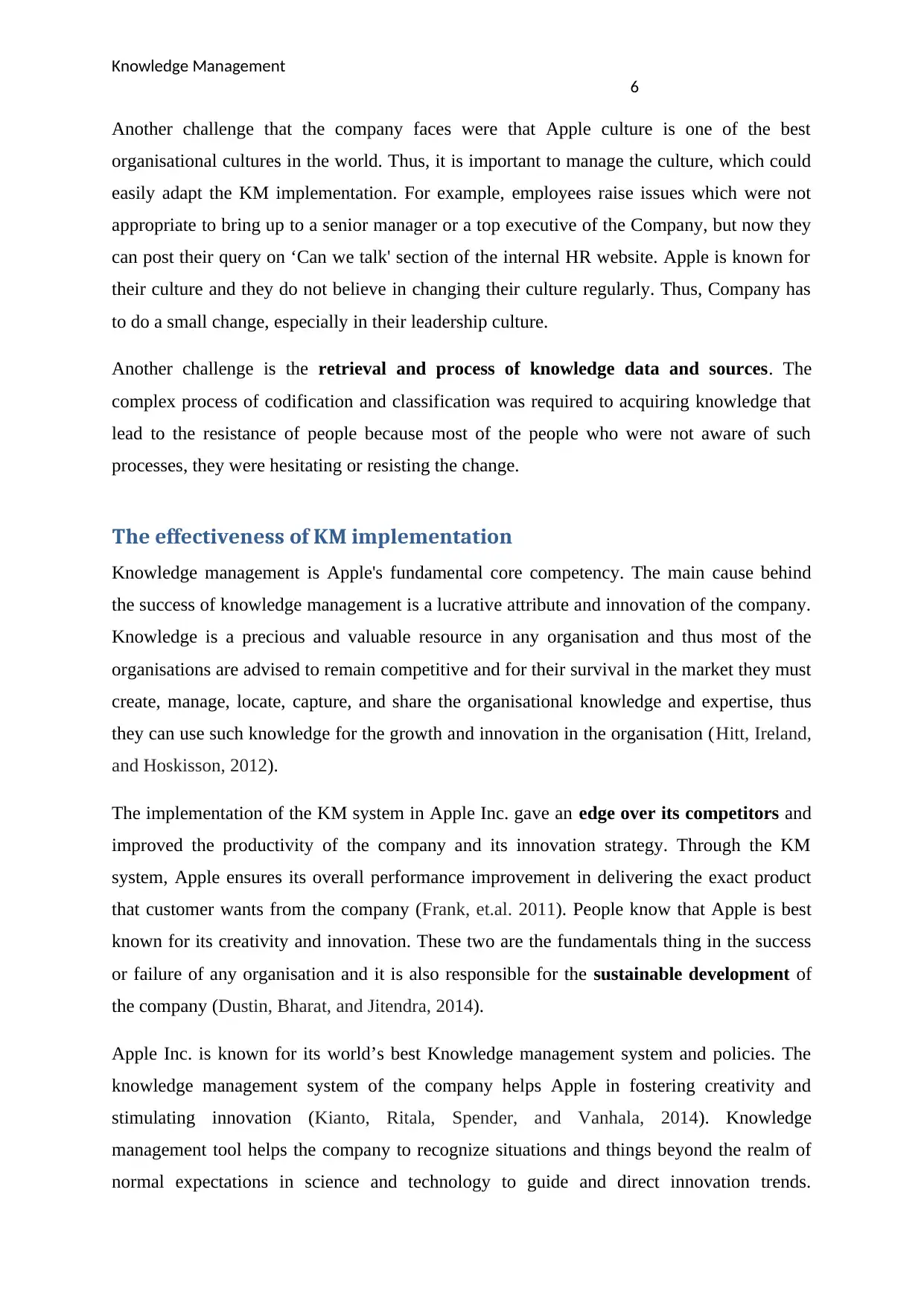
Knowledge Management
6
Another challenge that the company faces were that Apple culture is one of the best
organisational cultures in the world. Thus, it is important to manage the culture, which could
easily adapt the KM implementation. For example, employees raise issues which were not
appropriate to bring up to a senior manager or a top executive of the Company, but now they
can post their query on ‘Can we talk' section of the internal HR website. Apple is known for
their culture and they do not believe in changing their culture regularly. Thus, Company has
to do a small change, especially in their leadership culture.
Another challenge is the retrieval and process of knowledge data and sources. The
complex process of codification and classification was required to acquiring knowledge that
lead to the resistance of people because most of the people who were not aware of such
processes, they were hesitating or resisting the change.
The effectiveness of KM implementation
Knowledge management is Apple's fundamental core competency. The main cause behind
the success of knowledge management is a lucrative attribute and innovation of the company.
Knowledge is a precious and valuable resource in any organisation and thus most of the
organisations are advised to remain competitive and for their survival in the market they must
create, manage, locate, capture, and share the organisational knowledge and expertise, thus
they can use such knowledge for the growth and innovation in the organisation (Hitt, Ireland,
and Hoskisson, 2012).
The implementation of the KM system in Apple Inc. gave an edge over its competitors and
improved the productivity of the company and its innovation strategy. Through the KM
system, Apple ensures its overall performance improvement in delivering the exact product
that customer wants from the company (Frank, et.al. 2011). People know that Apple is best
known for its creativity and innovation. These two are the fundamentals thing in the success
or failure of any organisation and it is also responsible for the sustainable development of
the company (Dustin, Bharat, and Jitendra, 2014).
Apple Inc. is known for its world’s best Knowledge management system and policies. The
knowledge management system of the company helps Apple in fostering creativity and
stimulating innovation (Kianto, Ritala, Spender, and Vanhala, 2014). Knowledge
management tool helps the company to recognize situations and things beyond the realm of
normal expectations in science and technology to guide and direct innovation trends.
6
Another challenge that the company faces were that Apple culture is one of the best
organisational cultures in the world. Thus, it is important to manage the culture, which could
easily adapt the KM implementation. For example, employees raise issues which were not
appropriate to bring up to a senior manager or a top executive of the Company, but now they
can post their query on ‘Can we talk' section of the internal HR website. Apple is known for
their culture and they do not believe in changing their culture regularly. Thus, Company has
to do a small change, especially in their leadership culture.
Another challenge is the retrieval and process of knowledge data and sources. The
complex process of codification and classification was required to acquiring knowledge that
lead to the resistance of people because most of the people who were not aware of such
processes, they were hesitating or resisting the change.
The effectiveness of KM implementation
Knowledge management is Apple's fundamental core competency. The main cause behind
the success of knowledge management is a lucrative attribute and innovation of the company.
Knowledge is a precious and valuable resource in any organisation and thus most of the
organisations are advised to remain competitive and for their survival in the market they must
create, manage, locate, capture, and share the organisational knowledge and expertise, thus
they can use such knowledge for the growth and innovation in the organisation (Hitt, Ireland,
and Hoskisson, 2012).
The implementation of the KM system in Apple Inc. gave an edge over its competitors and
improved the productivity of the company and its innovation strategy. Through the KM
system, Apple ensures its overall performance improvement in delivering the exact product
that customer wants from the company (Frank, et.al. 2011). People know that Apple is best
known for its creativity and innovation. These two are the fundamentals thing in the success
or failure of any organisation and it is also responsible for the sustainable development of
the company (Dustin, Bharat, and Jitendra, 2014).
Apple Inc. is known for its world’s best Knowledge management system and policies. The
knowledge management system of the company helps Apple in fostering creativity and
stimulating innovation (Kianto, Ritala, Spender, and Vanhala, 2014). Knowledge
management tool helps the company to recognize situations and things beyond the realm of
normal expectations in science and technology to guide and direct innovation trends.
Paraphrase This Document
Need a fresh take? Get an instant paraphrase of this document with our AI Paraphraser
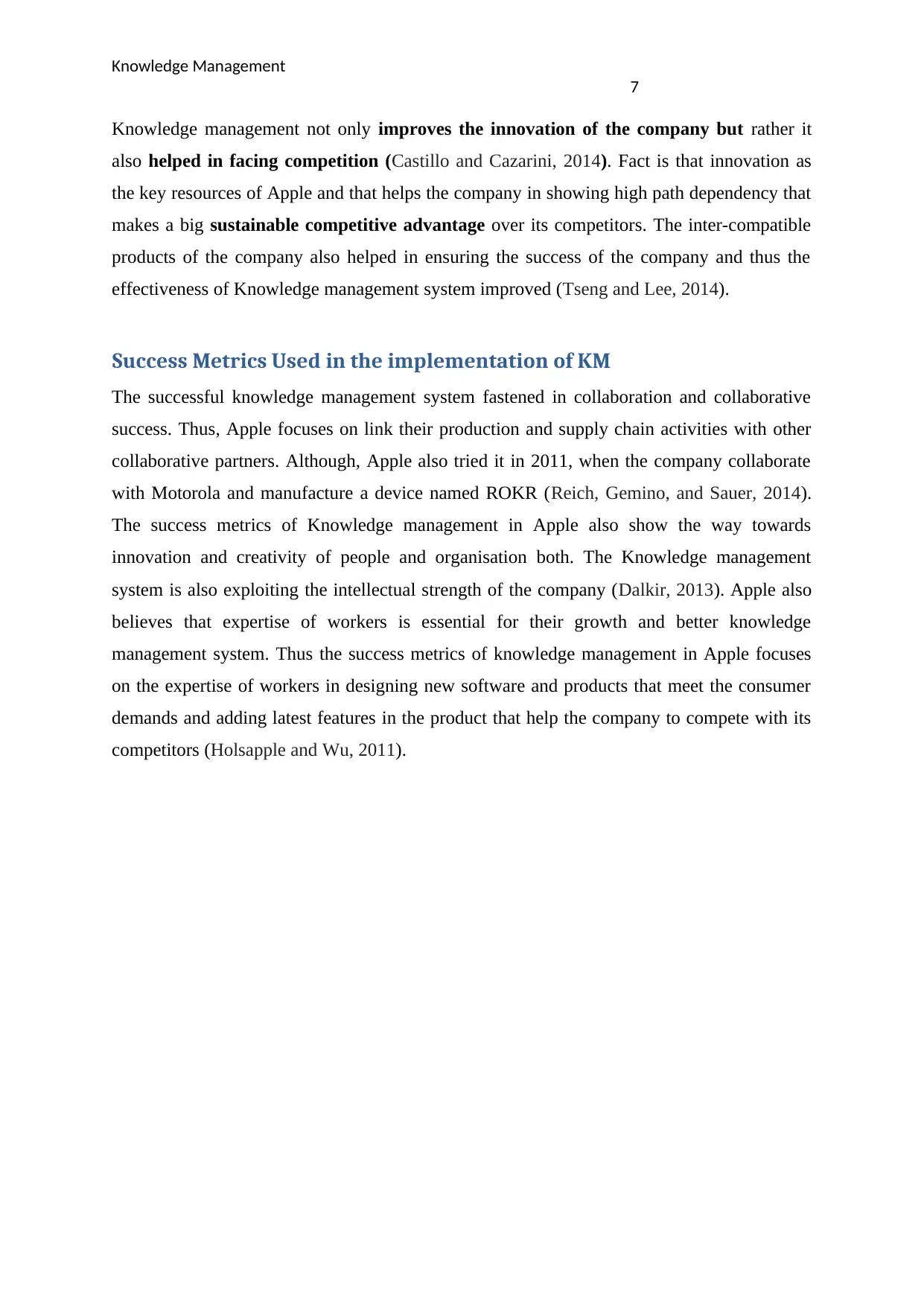
Knowledge Management
7
Knowledge management not only improves the innovation of the company but rather it
also helped in facing competition (Castillo and Cazarini, 2014). Fact is that innovation as
the key resources of Apple and that helps the company in showing high path dependency that
makes a big sustainable competitive advantage over its competitors. The inter-compatible
products of the company also helped in ensuring the success of the company and thus the
effectiveness of Knowledge management system improved (Tseng and Lee, 2014).
Success Metrics Used in the implementation of KM
The successful knowledge management system fastened in collaboration and collaborative
success. Thus, Apple focuses on link their production and supply chain activities with other
collaborative partners. Although, Apple also tried it in 2011, when the company collaborate
with Motorola and manufacture a device named ROKR (Reich, Gemino, and Sauer, 2014).
The success metrics of Knowledge management in Apple also show the way towards
innovation and creativity of people and organisation both. The Knowledge management
system is also exploiting the intellectual strength of the company (Dalkir, 2013). Apple also
believes that expertise of workers is essential for their growth and better knowledge
management system. Thus the success metrics of knowledge management in Apple focuses
on the expertise of workers in designing new software and products that meet the consumer
demands and adding latest features in the product that help the company to compete with its
competitors (Holsapple and Wu, 2011).
7
Knowledge management not only improves the innovation of the company but rather it
also helped in facing competition (Castillo and Cazarini, 2014). Fact is that innovation as
the key resources of Apple and that helps the company in showing high path dependency that
makes a big sustainable competitive advantage over its competitors. The inter-compatible
products of the company also helped in ensuring the success of the company and thus the
effectiveness of Knowledge management system improved (Tseng and Lee, 2014).
Success Metrics Used in the implementation of KM
The successful knowledge management system fastened in collaboration and collaborative
success. Thus, Apple focuses on link their production and supply chain activities with other
collaborative partners. Although, Apple also tried it in 2011, when the company collaborate
with Motorola and manufacture a device named ROKR (Reich, Gemino, and Sauer, 2014).
The success metrics of Knowledge management in Apple also show the way towards
innovation and creativity of people and organisation both. The Knowledge management
system is also exploiting the intellectual strength of the company (Dalkir, 2013). Apple also
believes that expertise of workers is essential for their growth and better knowledge
management system. Thus the success metrics of knowledge management in Apple focuses
on the expertise of workers in designing new software and products that meet the consumer
demands and adding latest features in the product that help the company to compete with its
competitors (Holsapple and Wu, 2011).
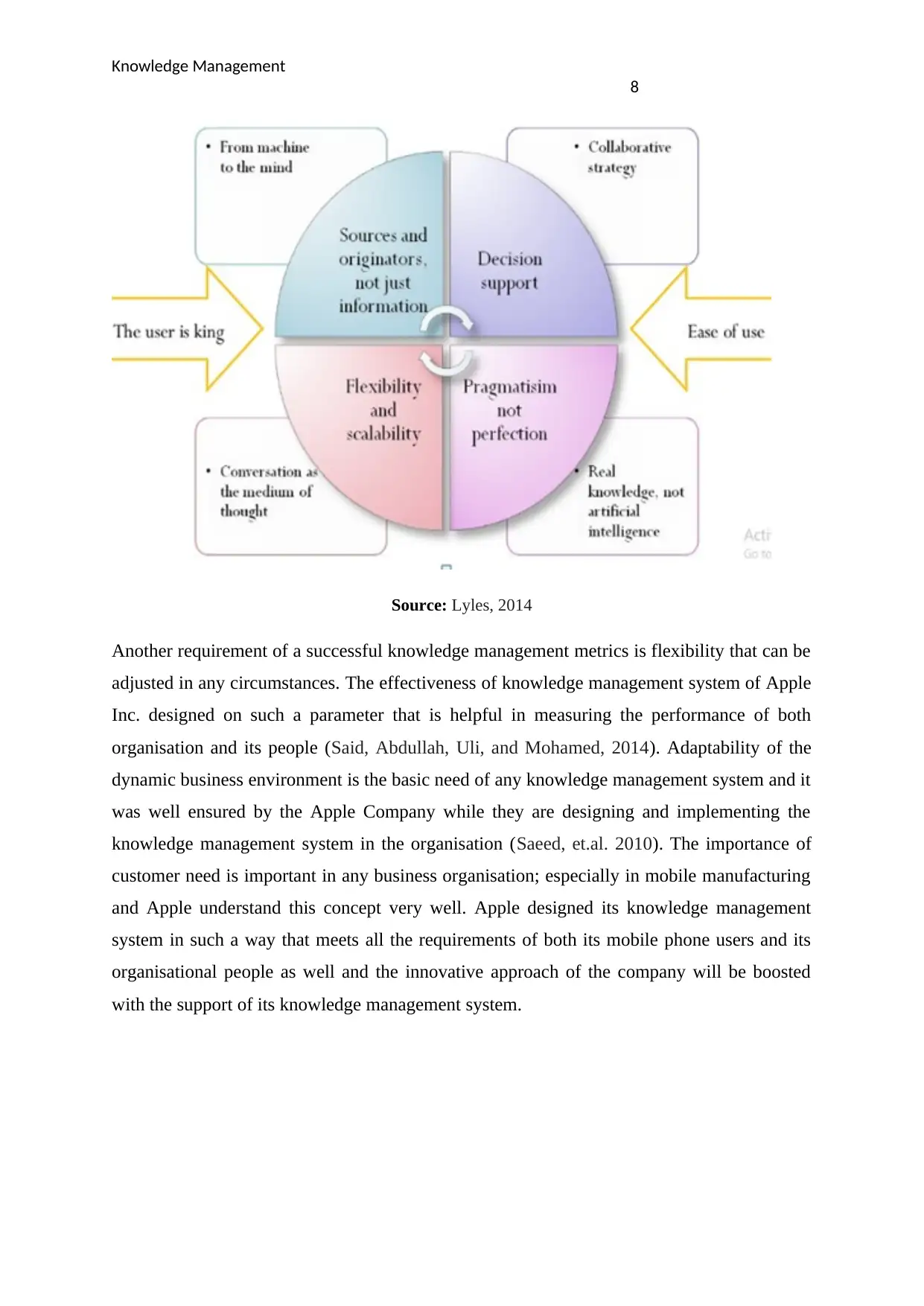
Knowledge Management
8
Source: Lyles, 2014
Another requirement of a successful knowledge management metrics is flexibility that can be
adjusted in any circumstances. The effectiveness of knowledge management system of Apple
Inc. designed on such a parameter that is helpful in measuring the performance of both
organisation and its people (Said, Abdullah, Uli, and Mohamed, 2014). Adaptability of the
dynamic business environment is the basic need of any knowledge management system and it
was well ensured by the Apple Company while they are designing and implementing the
knowledge management system in the organisation (Saeed, et.al. 2010). The importance of
customer need is important in any business organisation; especially in mobile manufacturing
and Apple understand this concept very well. Apple designed its knowledge management
system in such a way that meets all the requirements of both its mobile phone users and its
organisational people as well and the innovative approach of the company will be boosted
with the support of its knowledge management system.
8
Source: Lyles, 2014
Another requirement of a successful knowledge management metrics is flexibility that can be
adjusted in any circumstances. The effectiveness of knowledge management system of Apple
Inc. designed on such a parameter that is helpful in measuring the performance of both
organisation and its people (Said, Abdullah, Uli, and Mohamed, 2014). Adaptability of the
dynamic business environment is the basic need of any knowledge management system and it
was well ensured by the Apple Company while they are designing and implementing the
knowledge management system in the organisation (Saeed, et.al. 2010). The importance of
customer need is important in any business organisation; especially in mobile manufacturing
and Apple understand this concept very well. Apple designed its knowledge management
system in such a way that meets all the requirements of both its mobile phone users and its
organisational people as well and the innovative approach of the company will be boosted
with the support of its knowledge management system.
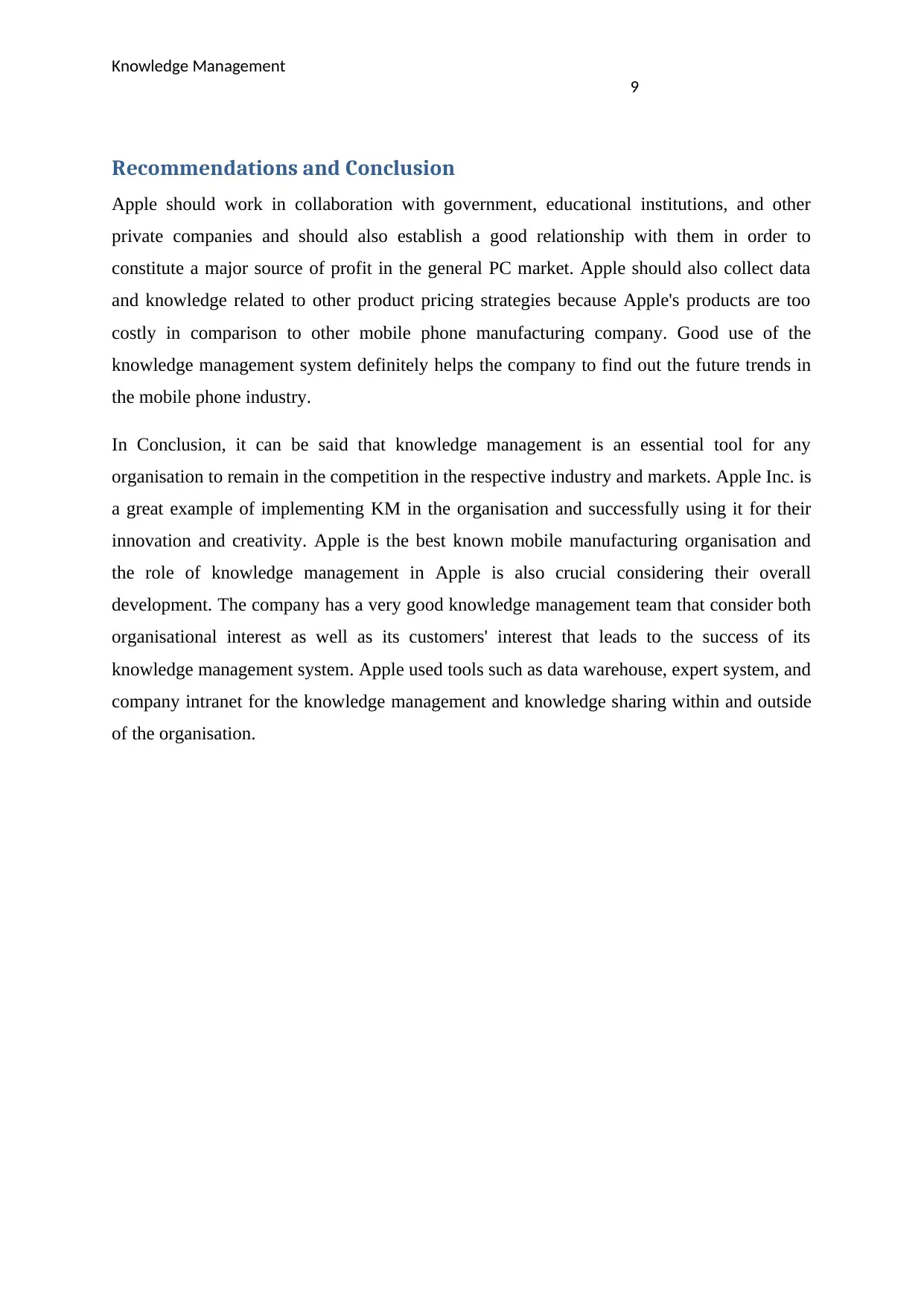
Knowledge Management
9
Recommendations and Conclusion
Apple should work in collaboration with government, educational institutions, and other
private companies and should also establish a good relationship with them in order to
constitute a major source of profit in the general PC market. Apple should also collect data
and knowledge related to other product pricing strategies because Apple's products are too
costly in comparison to other mobile phone manufacturing company. Good use of the
knowledge management system definitely helps the company to find out the future trends in
the mobile phone industry.
In Conclusion, it can be said that knowledge management is an essential tool for any
organisation to remain in the competition in the respective industry and markets. Apple Inc. is
a great example of implementing KM in the organisation and successfully using it for their
innovation and creativity. Apple is the best known mobile manufacturing organisation and
the role of knowledge management in Apple is also crucial considering their overall
development. The company has a very good knowledge management team that consider both
organisational interest as well as its customers' interest that leads to the success of its
knowledge management system. Apple used tools such as data warehouse, expert system, and
company intranet for the knowledge management and knowledge sharing within and outside
of the organisation.
9
Recommendations and Conclusion
Apple should work in collaboration with government, educational institutions, and other
private companies and should also establish a good relationship with them in order to
constitute a major source of profit in the general PC market. Apple should also collect data
and knowledge related to other product pricing strategies because Apple's products are too
costly in comparison to other mobile phone manufacturing company. Good use of the
knowledge management system definitely helps the company to find out the future trends in
the mobile phone industry.
In Conclusion, it can be said that knowledge management is an essential tool for any
organisation to remain in the competition in the respective industry and markets. Apple Inc. is
a great example of implementing KM in the organisation and successfully using it for their
innovation and creativity. Apple is the best known mobile manufacturing organisation and
the role of knowledge management in Apple is also crucial considering their overall
development. The company has a very good knowledge management team that consider both
organisational interest as well as its customers' interest that leads to the success of its
knowledge management system. Apple used tools such as data warehouse, expert system, and
company intranet for the knowledge management and knowledge sharing within and outside
of the organisation.
Secure Best Marks with AI Grader
Need help grading? Try our AI Grader for instant feedback on your assignments.
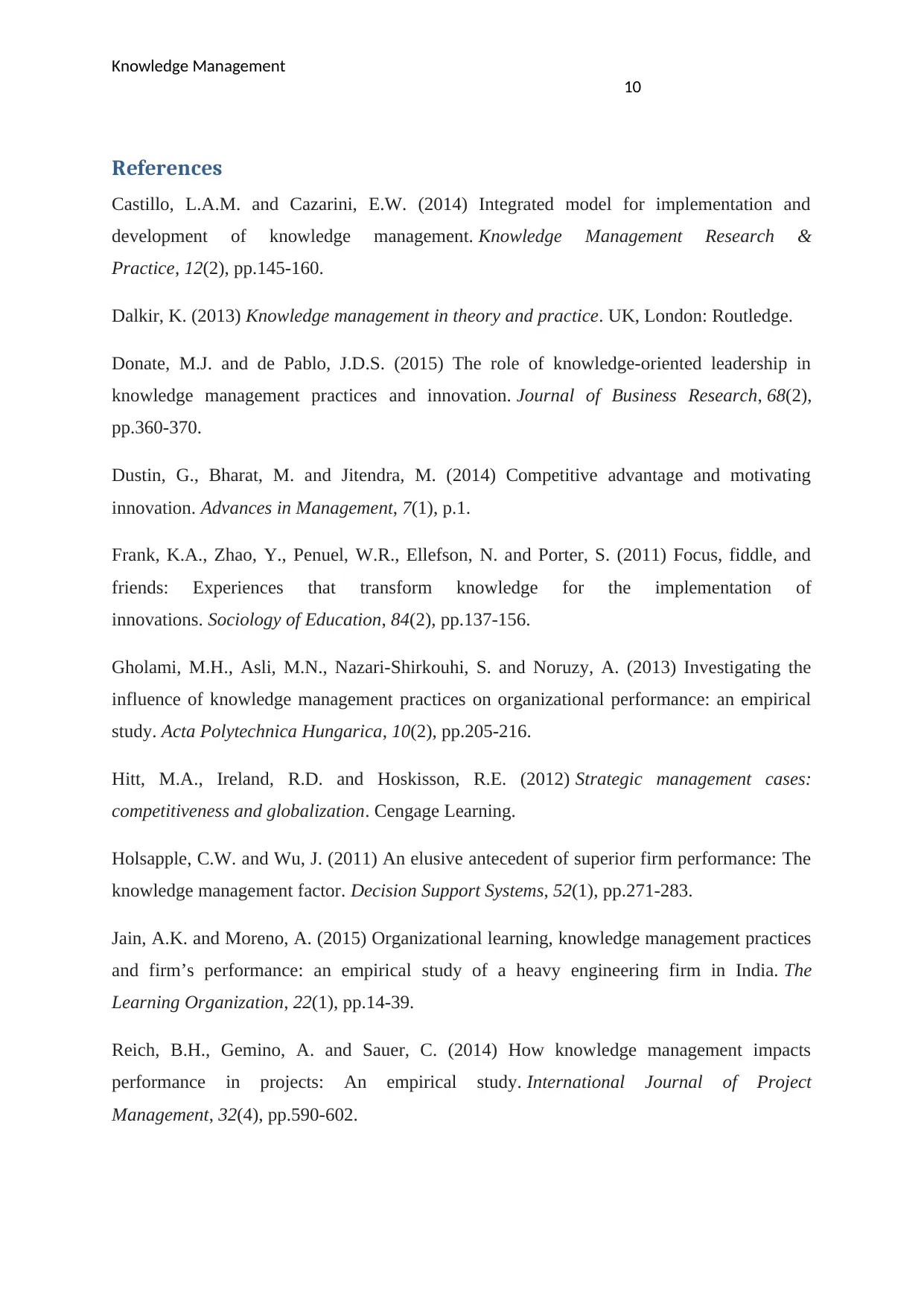
Knowledge Management
10
References
Castillo, L.A.M. and Cazarini, E.W. (2014) Integrated model for implementation and
development of knowledge management. Knowledge Management Research &
Practice, 12(2), pp.145-160.
Dalkir, K. (2013) Knowledge management in theory and practice. UK, London: Routledge.
Donate, M.J. and de Pablo, J.D.S. (2015) The role of knowledge-oriented leadership in
knowledge management practices and innovation. Journal of Business Research, 68(2),
pp.360-370.
Dustin, G., Bharat, M. and Jitendra, M. (2014) Competitive advantage and motivating
innovation. Advances in Management, 7(1), p.1.
Frank, K.A., Zhao, Y., Penuel, W.R., Ellefson, N. and Porter, S. (2011) Focus, fiddle, and
friends: Experiences that transform knowledge for the implementation of
innovations. Sociology of Education, 84(2), pp.137-156.
Gholami, M.H., Asli, M.N., Nazari-Shirkouhi, S. and Noruzy, A. (2013) Investigating the
influence of knowledge management practices on organizational performance: an empirical
study. Acta Polytechnica Hungarica, 10(2), pp.205-216.
Hitt, M.A., Ireland, R.D. and Hoskisson, R.E. (2012) Strategic management cases:
competitiveness and globalization. Cengage Learning.
Holsapple, C.W. and Wu, J. (2011) An elusive antecedent of superior firm performance: The
knowledge management factor. Decision Support Systems, 52(1), pp.271-283.
Jain, A.K. and Moreno, A. (2015) Organizational learning, knowledge management practices
and firm’s performance: an empirical study of a heavy engineering firm in India. The
Learning Organization, 22(1), pp.14-39.
Reich, B.H., Gemino, A. and Sauer, C. (2014) How knowledge management impacts
performance in projects: An empirical study. International Journal of Project
Management, 32(4), pp.590-602.
10
References
Castillo, L.A.M. and Cazarini, E.W. (2014) Integrated model for implementation and
development of knowledge management. Knowledge Management Research &
Practice, 12(2), pp.145-160.
Dalkir, K. (2013) Knowledge management in theory and practice. UK, London: Routledge.
Donate, M.J. and de Pablo, J.D.S. (2015) The role of knowledge-oriented leadership in
knowledge management practices and innovation. Journal of Business Research, 68(2),
pp.360-370.
Dustin, G., Bharat, M. and Jitendra, M. (2014) Competitive advantage and motivating
innovation. Advances in Management, 7(1), p.1.
Frank, K.A., Zhao, Y., Penuel, W.R., Ellefson, N. and Porter, S. (2011) Focus, fiddle, and
friends: Experiences that transform knowledge for the implementation of
innovations. Sociology of Education, 84(2), pp.137-156.
Gholami, M.H., Asli, M.N., Nazari-Shirkouhi, S. and Noruzy, A. (2013) Investigating the
influence of knowledge management practices on organizational performance: an empirical
study. Acta Polytechnica Hungarica, 10(2), pp.205-216.
Hitt, M.A., Ireland, R.D. and Hoskisson, R.E. (2012) Strategic management cases:
competitiveness and globalization. Cengage Learning.
Holsapple, C.W. and Wu, J. (2011) An elusive antecedent of superior firm performance: The
knowledge management factor. Decision Support Systems, 52(1), pp.271-283.
Jain, A.K. and Moreno, A. (2015) Organizational learning, knowledge management practices
and firm’s performance: an empirical study of a heavy engineering firm in India. The
Learning Organization, 22(1), pp.14-39.
Reich, B.H., Gemino, A. and Sauer, C. (2014) How knowledge management impacts
performance in projects: An empirical study. International Journal of Project
Management, 32(4), pp.590-602.
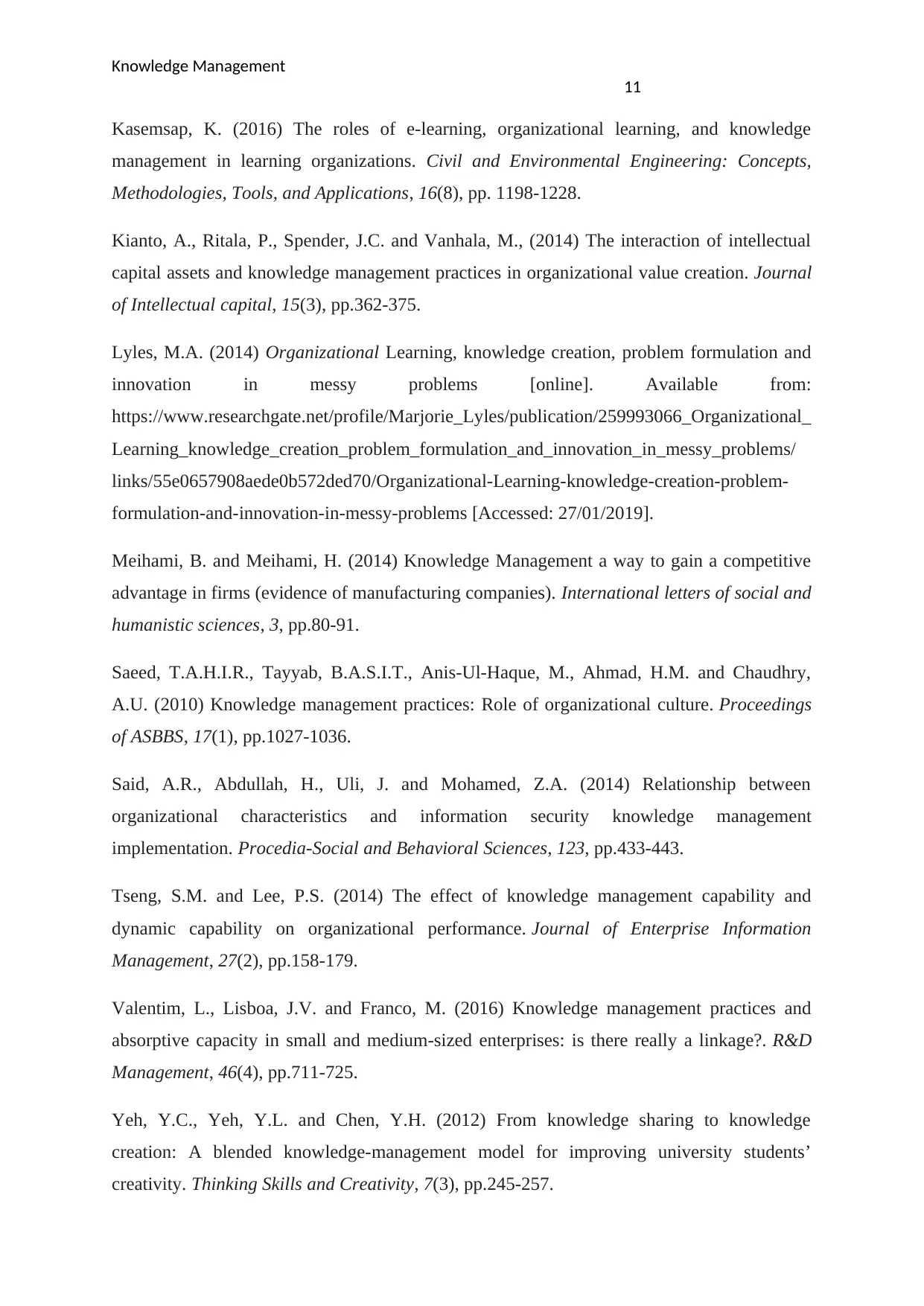
Knowledge Management
11
Kasemsap, K. (2016) The roles of e-learning, organizational learning, and knowledge
management in learning organizations. Civil and Environmental Engineering: Concepts,
Methodologies, Tools, and Applications, 16(8), pp. 1198-1228.
Kianto, A., Ritala, P., Spender, J.C. and Vanhala, M., (2014) The interaction of intellectual
capital assets and knowledge management practices in organizational value creation. Journal
of Intellectual capital, 15(3), pp.362-375.
Lyles, M.A. (2014) Organizational Learning, knowledge creation, problem formulation and
innovation in messy problems [online]. Available from:
https://www.researchgate.net/profile/Marjorie_Lyles/publication/259993066_Organizational_
Learning_knowledge_creation_problem_formulation_and_innovation_in_messy_problems/
links/55e0657908aede0b572ded70/Organizational-Learning-knowledge-creation-problem-
formulation-and-innovation-in-messy-problems [Accessed: 27/01/2019].
Meihami, B. and Meihami, H. (2014) Knowledge Management a way to gain a competitive
advantage in firms (evidence of manufacturing companies). International letters of social and
humanistic sciences, 3, pp.80-91.
Saeed, T.A.H.I.R., Tayyab, B.A.S.I.T., Anis-Ul-Haque, M., Ahmad, H.M. and Chaudhry,
A.U. (2010) Knowledge management practices: Role of organizational culture. Proceedings
of ASBBS, 17(1), pp.1027-1036.
Said, A.R., Abdullah, H., Uli, J. and Mohamed, Z.A. (2014) Relationship between
organizational characteristics and information security knowledge management
implementation. Procedia-Social and Behavioral Sciences, 123, pp.433-443.
Tseng, S.M. and Lee, P.S. (2014) The effect of knowledge management capability and
dynamic capability on organizational performance. Journal of Enterprise Information
Management, 27(2), pp.158-179.
Valentim, L., Lisboa, J.V. and Franco, M. (2016) Knowledge management practices and
absorptive capacity in small and medium‐sized enterprises: is there really a linkage?. R&D
Management, 46(4), pp.711-725.
Yeh, Y.C., Yeh, Y.L. and Chen, Y.H. (2012) From knowledge sharing to knowledge
creation: A blended knowledge-management model for improving university students’
creativity. Thinking Skills and Creativity, 7(3), pp.245-257.
11
Kasemsap, K. (2016) The roles of e-learning, organizational learning, and knowledge
management in learning organizations. Civil and Environmental Engineering: Concepts,
Methodologies, Tools, and Applications, 16(8), pp. 1198-1228.
Kianto, A., Ritala, P., Spender, J.C. and Vanhala, M., (2014) The interaction of intellectual
capital assets and knowledge management practices in organizational value creation. Journal
of Intellectual capital, 15(3), pp.362-375.
Lyles, M.A. (2014) Organizational Learning, knowledge creation, problem formulation and
innovation in messy problems [online]. Available from:
https://www.researchgate.net/profile/Marjorie_Lyles/publication/259993066_Organizational_
Learning_knowledge_creation_problem_formulation_and_innovation_in_messy_problems/
links/55e0657908aede0b572ded70/Organizational-Learning-knowledge-creation-problem-
formulation-and-innovation-in-messy-problems [Accessed: 27/01/2019].
Meihami, B. and Meihami, H. (2014) Knowledge Management a way to gain a competitive
advantage in firms (evidence of manufacturing companies). International letters of social and
humanistic sciences, 3, pp.80-91.
Saeed, T.A.H.I.R., Tayyab, B.A.S.I.T., Anis-Ul-Haque, M., Ahmad, H.M. and Chaudhry,
A.U. (2010) Knowledge management practices: Role of organizational culture. Proceedings
of ASBBS, 17(1), pp.1027-1036.
Said, A.R., Abdullah, H., Uli, J. and Mohamed, Z.A. (2014) Relationship between
organizational characteristics and information security knowledge management
implementation. Procedia-Social and Behavioral Sciences, 123, pp.433-443.
Tseng, S.M. and Lee, P.S. (2014) The effect of knowledge management capability and
dynamic capability on organizational performance. Journal of Enterprise Information
Management, 27(2), pp.158-179.
Valentim, L., Lisboa, J.V. and Franco, M. (2016) Knowledge management practices and
absorptive capacity in small and medium‐sized enterprises: is there really a linkage?. R&D
Management, 46(4), pp.711-725.
Yeh, Y.C., Yeh, Y.L. and Chen, Y.H. (2012) From knowledge sharing to knowledge
creation: A blended knowledge-management model for improving university students’
creativity. Thinking Skills and Creativity, 7(3), pp.245-257.
1 out of 12
Related Documents
Your All-in-One AI-Powered Toolkit for Academic Success.
+13062052269
info@desklib.com
Available 24*7 on WhatsApp / Email
![[object Object]](/_next/static/media/star-bottom.7253800d.svg)
Unlock your academic potential
© 2024 | Zucol Services PVT LTD | All rights reserved.





